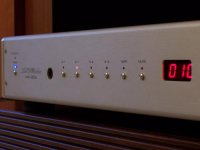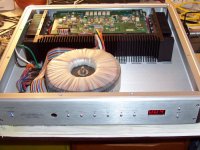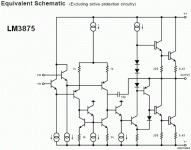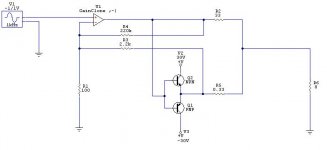widowmaker said:Chip Amp (doesn't matter wich one) and High-Fidelity are quite different concepts
If you're not able to sense the differencies....


The differences are clear as water, don't worry.
This amp was a huge downgrade to my system, when I tested it some time ago.
It's like throwing a blanket over my speakers.
LM3886 power amp back in, REAL music is back. 😉
Attachments
carlosfm said:The differences are clear as water, don't worry.
This amp was a huge downgrade to my system, when I tested it some time ago.
It's like throwing a blanket over my speakers.
LM3886 power amp back in, REAL music is back. 😉
This is a factory made, conventional, not DIY amp...
I want to add some comments about High End and High Fidelity:
Really High End amplifiers are not made by some stupid engineers from known "great" manifacturers...even they have label "high-end".
Hiroyasu Kondo... and many other are the men who can make the real sound...
Death Of Gain Clone
Have all you solid state guys forgot that current dumping feed forward NFB can easily be applied to a chip amp??? Hmmmmm....... Then you have a common substrate current class A up to out puts and matched Qausi out-puts and feedfoward current dump for the outs. oh yea and you onlu have to add 2 resistors an inductor and 2 caps.
Have all you solid state guys forgot that current dumping feed forward NFB can easily be applied to a chip amp??? Hmmmmm....... Then you have a common substrate current class A up to out puts and matched Qausi out-puts and feedfoward current dump for the outs. oh yea and you onlu have to add 2 resistors an inductor and 2 caps.
That sound interesting... can you show?
How about traditional ZEN amplifier with some addition CurrentDumping output stage, would that be possible?
Or didI understand correctly, that for proper CurrrentDumping to work you need nearly infinite openlop gain (opamp like..)?
How about traditional ZEN amplifier with some addition CurrentDumping output stage, would that be possible?
Or didI understand correctly, that for proper CurrrentDumping to work you need nearly infinite openlop gain (opamp like..)?
Death Of Gain Clone
Yes I believe you will need a stable unity gain chip, but the lm38-- series could work useing a lm318 buffer useing a global feed forward
network. basicaly you should get the best of all worlds.
Yes I believe you will need a stable unity gain chip, but the lm38-- series could work useing a lm318 buffer useing a global feed forward
network. basicaly you should get the best of all worlds.
In this cause (chip amp) you have more components (inside in chip) than I have in my schematic...
More components=poorer sound quality...it is a fact...
QUAD 405 has a lot of components and this is the reason for his oblivion...
More open loop gain...yes, but not much more, just enough...
More components=poorer sound quality...it is a fact...
QUAD 405 has a lot of components and this is the reason for his oblivion...
More open loop gain...yes, but not much more, just enough...
Death Of Gain Clone
Dont get me wrong widowmaker you design looks to be very good and I will probably try it, but from the gain clone stand point everybodys looking for the next great breakthrough and when people get excited about adding a snubber to there clones power supply, well you get the idea.... I would love to see some more information possible some pics of your amp????
Dont get me wrong widowmaker you design looks to be very good and I will probably try it, but from the gain clone stand point everybodys looking for the next great breakthrough and when people get excited about adding a snubber to there clones power supply, well you get the idea.... I would love to see some more information possible some pics of your amp????
Re: Death Of Gain Clone
Inside? Power supply?
Power supply is separately for class A and current dumpers
I have CLC filters on PS for class A.
2SK301R working @ Id=7mA (each). They are matched pairs - Id=10-11mA @ Ugs=0V.
More Id = more open loop gain.
Current mirror helps for increasing the open loop gain too.
As you see I don't put the source resistor on IRF9610.
The reason is the same...
What exactly you want to see?tiltedhalo said:I would love to see some more information possible some pics of your amp???? [/B]
Inside? Power supply?
Power supply is separately for class A and current dumpers
I have CLC filters on PS for class A.
2SK301R working @ Id=7mA (each). They are matched pairs - Id=10-11mA @ Ugs=0V.
More Id = more open loop gain.
Current mirror helps for increasing the open loop gain too.
As you see I don't put the source resistor on IRF9610.
The reason is the same...
widowmaker, you started an unnecessary discussion because of the name you gave to your discrete amp.
It beats your 'GC', so what?
I have beaten my 'GC' several times, even using the same chip, the LM3886.
In the same way you can give the same bunch of transistors to several people and they will make different amps with them, some good, some not so good.
And even more, following the same schematic, results can be different from implementation to implementation.
Btw I know the Krell is a commercial amp, and as most of them it has stupidity all around inside it.
The 750VA toroid is not bad, and the heatsinks would be salvageable too. 😀
It beats your 'GC', so what?
I have beaten my 'GC' several times, even using the same chip, the LM3886.
In the same way you can give the same bunch of transistors to several people and they will make different amps with them, some good, some not so good.
And even more, following the same schematic, results can be different from implementation to implementation.
Btw I know the Krell is a commercial amp, and as most of them it has stupidity all around inside it.
The 750VA toroid is not bad, and the heatsinks would be salvageable too. 😀
Attachments
🙂
It is true that LM3875, the most frequently use chip amp used in so called gainclone,
has more transistors than widowmaker amp DoGC.
See simplified schematic below.
Each current source makes at least 1 T, and active protection add several more.
We could make a chip without protection, but marketing this would not be good for business!
🙂
What is different in LM3875 toplogy compared to a 'normal' amplifier, for example DoGC?
- Two extra input transistors in the differential input stage (reduces input bias current)
- Second stage VAS is no different from normal amp
- Output stage uses only NPN Transistors - not normal
Would be an interesting project to build a
discrete version using same basic design topology as LM3875
Discrete Gainclone ....
hmmm, does it make sense calling it so .... 😉
It is true that LM3875, the most frequently use chip amp used in so called gainclone,
has more transistors than widowmaker amp DoGC.
See simplified schematic below.
Each current source makes at least 1 T, and active protection add several more.
We could make a chip without protection, but marketing this would not be good for business!
🙂
What is different in LM3875 toplogy compared to a 'normal' amplifier, for example DoGC?
- Two extra input transistors in the differential input stage (reduces input bias current)
- Second stage VAS is no different from normal amp
- Output stage uses only NPN Transistors - not normal
Would be an interesting project to build a
discrete version using same basic design topology as LM3875
Discrete Gainclone ....
hmmm, does it make sense calling it so .... 😉
Attachments
Great idea
I've never looked at equivalent schematic of this chip, but its topology looks damn clever.
This will be good adiophiles hearing differences in resistors , because R's in IC are probably of worst linearity and so on. 😀 100x worse than cheapest carbons.😉
I've never looked at equivalent schematic of this chip, but its topology looks damn clever.
This will be good adiophiles hearing differences in resistors , because R's in IC are probably of worst linearity and so on. 😀 100x worse than cheapest carbons.😉
Actually I like the output stage. A bit like quad and the error correction mechanism looks very clear, with output stage in class B except of C in quad I think.
lineup said:It is true that LM3875, the most frequently use chip amp used in so called gainclone,
has more transistors than widowmaker amp DoGC.
See simplified schematic below.
LM x875 has 4 stages, exept output darlingtons (quasicomplementary!!!):
1. input stage
2. diff amp with current mirror
3. emitter follower
4. common emiter with current source
In DoGC, again except output stage:
1. diff amp with current mirror
2. common source with current source
😎
The more I look at the DoGC schematic the more I appriciate it .. it's just a lovely simply, yet elegant amplifier circuit... with a twist, the current dumping current sources..
I took my JohnLinselyHood books and start reading about the Quad current dumping principle.. I don't think I quite understand it but would this work?
attachment:
It's just a proof of concept in my simulator NOT a real project.. the DoGC is a better solution I now understand.
I took my JohnLinselyHood books and start reading about the Quad current dumping principle.. I don't think I quite understand it but would this work?
attachment:
It's just a proof of concept in my simulator NOT a real project.. the DoGC is a better solution I now understand.
Attachments
I can explain how it works, but my english is not very good...
This is slightly dificult for me...🙁
The simply explanation is:
The bridge ( 2x1k; 120pF; 47 ohms; 4.5uH ) compare the signal between input and output point and add correction current in output of the amp, wich eliminates nonlinearity of dumpers.
The most important conditions are:
1. Balanced bridge for high frequencies - why for high frequencies? -
less open loop gain, more nonlinearity. In low frequencies we have more gain and negative feedback can correct nonlinearity of dumpers.
In this cause:
The most important component is the output inductor! Make it carefully and tight with thermoshrinkable pvc tube as shown on the picture.
First axial, after that radial.
2. A good and simply ( more components = more noise and nonlinearity) reference class A stage (preferable SE) with less components and a good open loop gain.
SRPP has a poorer sound quality vs. differential input stage.
This is slightly dificult for me...🙁
The simply explanation is:
The bridge ( 2x1k; 120pF; 47 ohms; 4.5uH ) compare the signal between input and output point and add correction current in output of the amp, wich eliminates nonlinearity of dumpers.
The most important conditions are:
1. Balanced bridge for high frequencies - why for high frequencies? -
less open loop gain, more nonlinearity. In low frequencies we have more gain and negative feedback can correct nonlinearity of dumpers.
In this cause:
The most important component is the output inductor! Make it carefully and tight with thermoshrinkable pvc tube as shown on the picture.
First axial, after that radial.
2. A good and simply ( more components = more noise and nonlinearity) reference class A stage (preferable SE) with less components and a good open loop gain.
SRPP has a poorer sound quality vs. differential input stage.
Hi, Darkfenriz
LM3875 Equivalent cct :
Darkfenriz, what do you think if this equivalent LM3875 cct is made to real discrete amplifier? Can the 3 diodes string (bias diode) replaced by VBE multiplier (for practical bias adjustment)? Is this replacement will ruin the error correction that you mentioned?
LM3875 Equivalent cct :
Yes, it is clever, especially the lower diode which connected to the VAS resistor.I've never looked at equivalent schematic of this chip, but its topology looks damn clever.
That's what I heard too. Inside chips, all resistors are capacitors are forced to be made of silicons, which are not good for capacitors or resistors.This will be good adiophiles hearing differences in resistors , because R's in IC are probably of worst linearity and so on. 100x worse than cheapest carbons.
What error correction do you mean? The lower diode connected to VAS resistor? I see this in LM3886 inside schematic too. Error correction usually have input and output to compare with. Which part do this in this LM3875 equivalent cct?Actually I like the output stage. A bit like quad and the error correction mechanism looks very clear, with output stage in class B except of C in quad I think.
Darkfenriz, what do you think if this equivalent LM3875 cct is made to real discrete amplifier? Can the 3 diodes string (bias diode) replaced by VBE multiplier (for practical bias adjustment)? Is this replacement will ruin the error correction that you mentioned?
lineup said:Would be an interesting project to build a
discrete version using same basic design topology as LM3875
Discrete Gainclone ....
hmmm, does it make sense calling it so .... 😉
This has been already proposed in some other thread: http://www.diyaudio.com/forums/showthread.php?s=&threadid=23228&highlight=
I think the advantage of a gainclone is actually having all parts in one tiny package. I would even speculate that the discrete circuit, even with the most exotic parts, will not sound as good.
Peter Daniel said:
We should keep it discreet in this thread.
I'm already tired of all those chip threads.
ICs, ICs and ICs, no creativity.
I'm starting building discrete amp too. I have too many big caps and heatsinks.
A quote from mentioned thread, posted by Peter Daniel 2003-11-26
But things change many times over a period of time
and only dead people never modify their own opinions.
😉
Nice reminder.
That was three years ago. I've built some of those dicrete amps, and went back to good 'ol gainclone.😉
And if you look even further into some of my earlier posts, I was always keeping ICs in very low esteem. Discrete had ruled than, but times, they are a-changin'.
That was three years ago. I've built some of those dicrete amps, and went back to good 'ol gainclone.😉
And if you look even further into some of my earlier posts, I was always keeping ICs in very low esteem. Discrete had ruled than, but times, they are a-changin'.
- Home
- Amplifiers
- Solid State
- Death of Gain Clone



